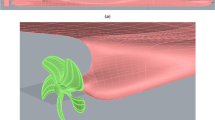Abstract
In the current study, the propulsion performance of a conventional ship is experimentally evaluated via self-propulsion tests under four different pre-swirl ducts compared to a case with no duct. For this purpose, the Series-60 ship was used as an intended conventional ship and the Mewis duct, the semicircular duct, and the Becker twisted fins duct were investigated. We also tested an improved Mewis duct by changing its hydrofoil section and chord length. The thrust and torque coefficients and the propulsive efficiency were analyzed to investigate the propulsion performance. According to our experimental measurements, we found that the thrust coefficient was increased and the torque coefficient was decreased using pre-swirl ducts compared to the case with no duct, especially for a higher Froude number. The highest value for the propulsive efficiency was achieved for the Mewis duct, the Becker twisted fins duct, and the semicircular duct, in the order of their appearance. We also found that the reduction in the Mewis duct’s chord length and a change in its hydrofoil type from the NACA4415 to the Nozzle A19 result in an increase in the propulsive efficiency.








Similar content being viewed by others
References
Mewis F (2008) Development of a novel power-saving device for full-form vessels. HANSA 145:46–50
Mewis F (2009) A novel power-saving device for full-form vessels. In: Proceedings of the first international symposium on marine propulsors (SMP’09), Trondheim
Kravitz E (2011) Analysis and experiments for contra-rotating propeller. Doctoral dissertation, Massachusetts Institute of Technology, USA
Wagner R (1929) Rückblick und Ausblick auf die Entwicklung des Contra propellers. In: Jahrbuch der Schiffbautechnischen Gesellschaft. Springer, Berlin
Mewis F, Peters HE (1986) Power savings through a novel fin system. In: SMSSH conference proceedings, Varna, Bulgaria
Lee JT, Kim MC, Suh JC, Kim SH, Choi JK(1992) Development of a pre swirl stator- propeller system for improvement of propulsion efficiency: a symmetric stator propulsion system. Transaction of SNAK, vol 29(4), Bussan, Korea
Sacks AH, Burnell JA (1962) Ducted propellers—a critical review of the state of the art. Prog Aerosp Sci 3:85–135
Van Lammeren WPA (1949) Enkele Constructies ter Verbetering van het Rendement van de Voorstuwing. Ship en Werf van, Rotterdam
Schneekluth H (1986) Wake equalizing duct. Nav Archit Lond 103:147–150
Carlton JS (2012) Marine propellers and propulsion. Butterworth, Heinemann
Sasaki N, Aono T (1997) Development of energy saving device ‘‘SILD’’. Sumitomo Tech Rev Rev. 135:47–50
Sasaki N, Aono T (1997) Energy saving device “SILD”. J Shipbuild 45
Guiard T, Leonard S (2013) The Becker Mewis Duct-challenges in full-scale design and new developments for fast ships. In: Proceedings of the 3rd international symposium on marine propulsor
Park S, Oh G, Rhee SH, Koo BY, Lee H (2015) Full scale wake prediction of an energy saving device by using computational fluid dynamics. Ocean Eng 101:254–263
Kim JH, Choi JE, Choi BJ, Chung SH, Seo HW (2015) Development of energy-saving devices for a full slow-speed ship through improving propulsion performance. Int J Nav Archit Ocean Eng 7:390–398
Sasaki N, Atlar M, Kuribayashi S (2016) Advantages of twin rudder system with asymmetric wing section aside a propeller. J Mar Sci Technol 21:297–308
Go JS, Yoon HS, Jung JH (2017) Effects of a duct before a propeller on propulsion performance. Ocean Eng 136:54–66
Mizzi K, Demirel YK, Banks C, Turan O, Kaklis P, Atlar M (2017) Design optimisation of Propeller Boss Cap Fins for enhanced propeller performance. Appl Ocean Res 62:210–222
Yuhai K, Cai R, Wang J, Zhang Y (2013) Numerical study of energy-saving mechanism of duct on a VLCC with real-geometry propeller. In: Proceedings of the third international symposium on marine propulsors (SMP’13), Launceston, Tasmania
Martinas G (2015) Cavitation of a propeller and influence of a wake equalizing duct. Int J Mar Navig Saf Sea Transp 9:235–241
https://ittc.info/members/member-organisations/national-iranian-marine-laboratory-nimala/
Propulsion Committee (2002) Final report and recommendations to the 23rd ITTC, proceeding of 23rd ITTC
Coleman H, Steele W (1999) Experimental and uncertainty analysis for engineers, 2nd edn. Wiley, New York
Calculating-Fuel-Consumption. http://www.boatingmag.com
Author information
Authors and Affiliations
Corresponding author
Additional information
Technical Editor: André Cavalieri.
Rights and permissions
About this article
Cite this article
Najafi, A., Nowruzi, H. & Hashemi, S.A. The effects of pre-swirl ducts on the propulsion performance of conventional ship: an experimental study. J Braz. Soc. Mech. Sci. Eng. 40, 552 (2018). https://doi.org/10.1007/s40430-018-1476-y
Received:
Accepted:
Published:
DOI: https://doi.org/10.1007/s40430-018-1476-y




